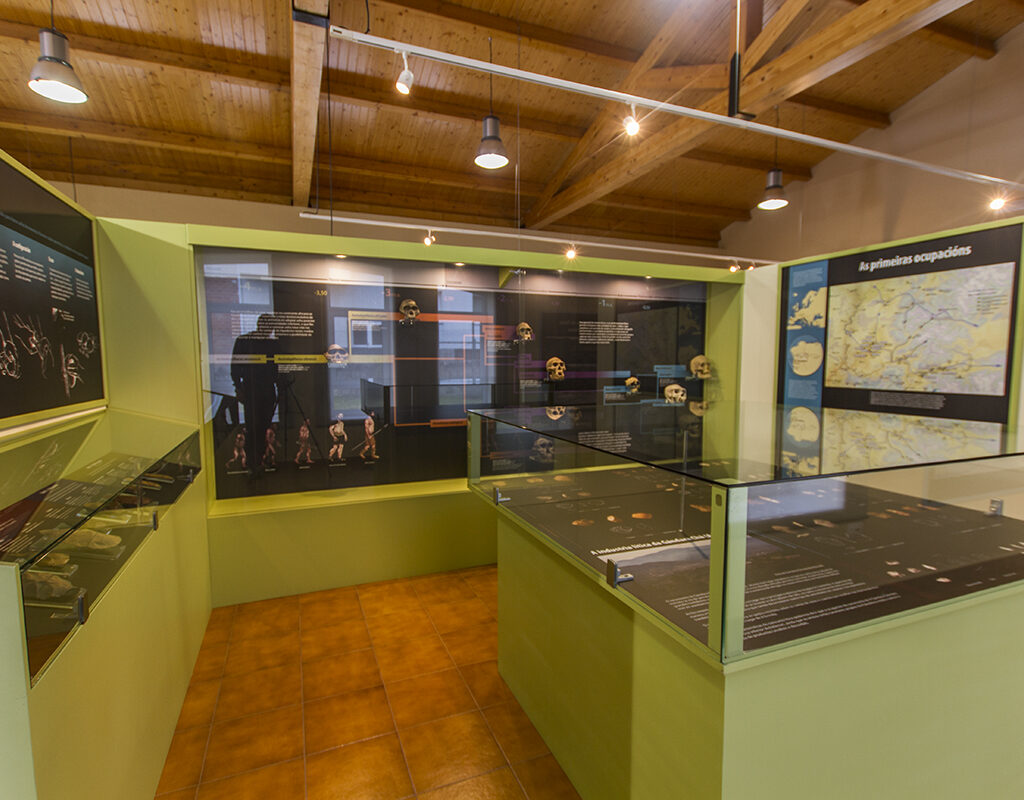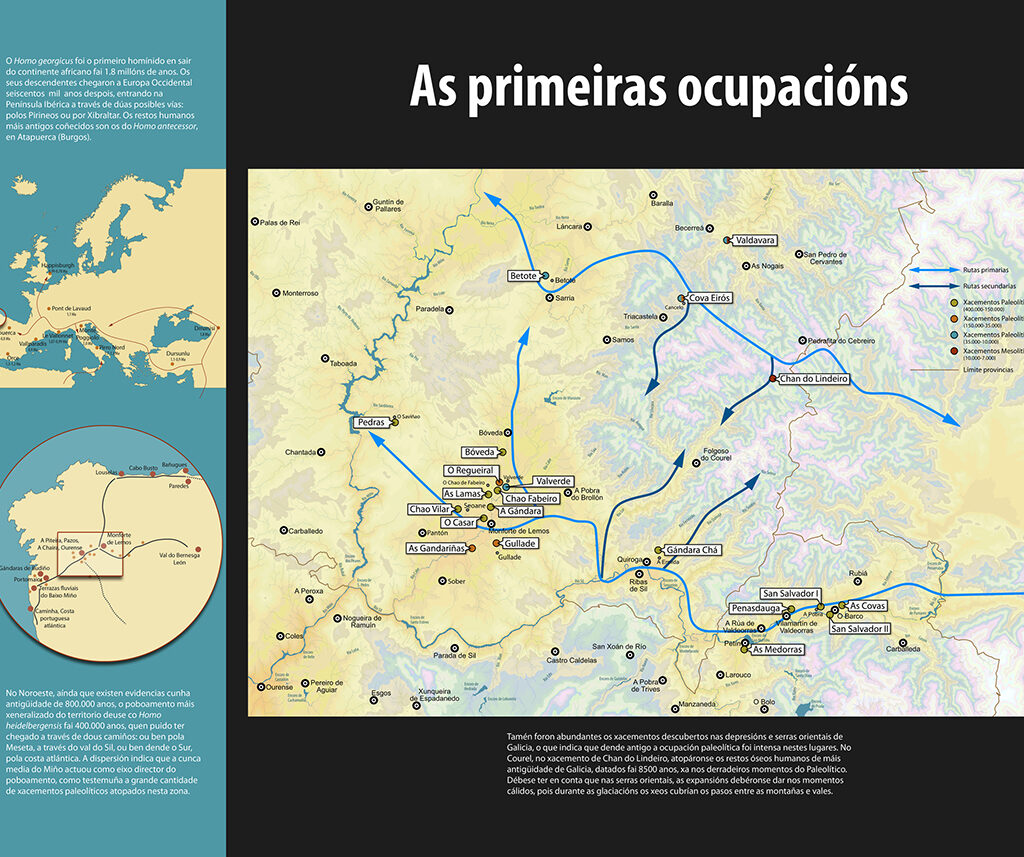
The First Human Settlements of Galicia
THE STORY OF ELBA, A NEOLITHIC WOMAN FROM THE O COUREL MOUNTAINS.
The first human occupations in the area and the use of stone by the first settlers based on the findings and research of recent years. How was the evolution of man from the first steps, his expansion up to here and his material production in the Paleolithic.

Homo georgicus was the first hominid to leave the African continent 1.8 million years ago. Their descendants reached Western Europe six hundred thousand years later, entering the Iberian Peninsula through two possible routes: through the Pyrenees or through Gibraltar. The oldest known human remains are those of Homo ancestor, in Atapuerca (Burgos).
In the northwest, although there is evidence dating back 800,000 years, the most widespread settlement of the territory occurred with Homo heidelbergensis 400,000 years ago, who could have arrived via two paths: either from the south, or from the Atlantic Coast. The dispersion indicates that the middle Miño basin acted as the directing axis of the settlement, as shown by the large number of Paleolithic sites found in this area.
There were also abundant deposits discovered in the depressions and eastern mountains of Galicia, which indicates that from remote times the Paleolithic occupation was intense in these places. In O Courel, at the Chan do Lindeiro site, the oldest human skeletal remains in Galicia were found, dating back 8,500 years, already in the last moments of the Paleolithic. It must be taken into account that in the eastern sierras, the expansions must have occurred during warm times, since during the glaciations the ice covered the passes between the mountains and valleys.

About 6 million years ago, hominids arose on the African continent, and with them our evolutionary destiny separated from that of chimpanzees. They were the first to adopt an upright position and walk on their lower limbs, which allowed them to climb down from the trees and start a new life in the savannahs and forests. The advantages of standing in these environments were better visual control of the environment and the possibility of transporting and manipulating objects.
Austrolopithecus anamensis
Austrolopithecus afarensis
Mean cranial volume: 415cc.
Average height of adult individual: 1.35m.
-Average adult individual weight: 45kg.
He was already bipedal.
Austrolopithecus africanus
Mean cranial volume: 445cc.
Average height of adult individual: 1.38m.
Average adult individual weight: 40 kg.
It was bipedal, though it had curved fingers and long arms for climbing trees.
Homo rudolfensis
Homo habilis
Mean cranial volume: 630cc.
Average height of adult individual: 1.30 m.
Average adult individual weight: 40 kg.
Increased cranial capacity. He is the first hominid to carve stone to make tools.
Paranthropus boisei
Mean cranial volume: 520 cc.
Average height of adult individual: 1.37 m.
Average adult individual weight: 49 kg.
It had a bony crest at the top of the skull to support the large facial muscles, adapted for eating vegetables and hard fruits.
Austrolopithecus sediba
Paranthropues robustus
Mean cranial volume: 520 cc.
Average height of adult individual: 1.32 m.
Average adult individual weight: 40 kg.
It had a large chewing apparatus adapted to the consumption of hard vegetables.
Homo ergaster
Homo georgicus
Homo erectus
Mean cranial volume: 1100 cc.
Average height of adult individual: 1.70 m.
Average adult individual weight: 65 kg.
Discover the use of fire and spread throughout Asia.
With the appearance of the genus Homo, the use of lithic tools made it possible to incorporate more meat into the diet, which contributed to an increase in the brain. Encephalization gave hominids the ability to plan in the long term, while increasing the social complexity of the groups, each time more numerous. Then it was possible to leave the African continent and adapt to different habitats, finally Homo Sapiens being the most successful.
Homo antecessor
Mean cranial volume: 1000 cc.
Average height of adult individual: 1.70 m.
Average adult individual weight: 70 kg.
It is the first hominid to inhabit Europe.
Homo heildelbergensis
Mean cranial volume: 1200 cc.
Average height of adult individual: 1.75 m.
Average adult individual weight: 95 kg.
It is the possible common ancestor between Homo sapiens and Neanderthals.
Homo Rhodesiensis
Homo Neanderthalensis
Mean cranial volume: 1450 cc.
Average height of adult individual: 1.65 m.
Average adult individual weight: 80 kg.
Emerged and extinct in the Near East and Europe, where it lived with H. sapiens.
Homo sapiens
Mean cranial volume: 1400 cc.
Average height of adult individual: 1.80 m.
Average adult individual weight: 80 kg.
Generalization of artistic manifestations and colonization of the planet.

LIFE IN THE PALEOLITHIC: THE WORK OF THE STONE
Hominids took advantage of the resources of the environment in which they lived to make their tools. Most of them, made of stone, are the main evidence we have today of Paleolithic occupations, since organic materials such as bone or antlers are not preserved in Galicia due to the acidity of the earth, with the exception of the limestone soils of the Northwest.
But not all stones were suitable for carving, rather those with a regular fracture and a certain hardness were chosen to be able to work on hard materials such as wood and leather. In Galicia, the local quartzite and pebble were especially used.
THE PROCESS BY A STONE IS TRANSFORMED BY THE HOMINIDS TO MAKE A TOOL IS CALLED OPERATING CHAIN, AND ITS COMPOSED OF THE FOLLOWING STEPS:
The supply
Hominids searched for boulders in the rivers to carve them and obtain sharp edges with which to carry out all their daily tasks as hunter-gatherers: cutting roots, hunting animals and scaling them, preparing skins, working wood, etc.
The production
By hitting two edges together, two products can be obtained: on the one hand, the main stone or core, on which it is struck, and on the other, the flakes or fragments extracted from it. Both the first and the second could be used as work instruments.
The use
The contact of lithic tools with different elements (skin, wood, bone…) leaves microscopic and specific “use marks” on the stone depending on the material worked, which today allow us to know the tasks performed by hominids.
Abandonment
When a piece became useless due to wear or because it was no longer useful, the hominid got rid of it and carved a new one to replace it.

THE UTENSILS SHAPE
MODE 1 OR OLDUVAIAN – IN EUROPE: 1.5-700000 B. P.
Homo habilis made utensils from boulders from rivers, which they struck directly with other stones, giving them a sharp and irregular edge that could be used, for example, to cut meat.
*Chopper
Chronology: Lower Paleolithic.
Chronocultural ascription: Olduvian.
Function: It was used for strength activities: fracturing bones, vegetables…
MODE 2 OR ACHELLE – IN EUROPE: 700000-250000 B. P.
Homo erectus was capable of producing large tools with standardized shapes, working the stone on both sides and on the entire surface, producing symmetrical pieces. In this way, he obtained the biface, with more regular edges and a pointed shape.
*TRIHEDRON
Chronology: Lower Paleolithic.
Chronocultural ascription: Acheulean.
Function: It had several uses, taking advantage of its sharp tip at the end: opening animal carcasses and digging roots or tubers.
*TRIHEDRON 2
Chronology: Lower Paleolithic.
Chronocultural ascription: Acheulean.
*BIFACE
Chronology: Lower Paleolithic.
Chronocultural ascription: Acheulean.
Function: It was used for a huge variety of tasks, from digging in the ground to cutting wood, although it was widely used to butcher hunted animals.
*BIFACE
Chronology: Lower Paleolithic.
Chronocultural ascription: Acheulean.
*PROTOBIFACE
Chronology: Lower Paleolithic.
Chronocultural affiliation: Abbevillense – Acheulean.
Function: Versatile morphology for chopping or cutting various materials such as wood, meat, bone…
MODE 3 OR MUSTERIAN – IN EUROPE: 250000-40000 B. P.
Homo neanderthalensis gave the main stone (core) a specific shape to later be able to extract flakes with very regular and standardized morphologies and make their tools with them, since they had a very clear notion of the desired instruments before carving.
*OVAL HAZE
Chronology: Middle Paleolithic.
Chronocultural ascription: Mousterian.
Function: It was used for a huge variety of tasks, from digging in the ground to cutting wood, although it was widely used to butcher hunted animals.
*RAEDER
Chronology: Middle Paleolithic.
Chronocultural ascription: Mousterian.
Function: Thanks to its edge, it was possible to remove fat, hair, etc., from the skin of animals or to work wood.
MODE 4 OR UPPER PALEOLITHIC – IN EUROPE: 40,000-10,000 B.P.
Homo sapiens managed to obtain very thin and elongated flakes (blades or blades) by carving the nuclei, to manufacture increasingly smaller and specialized utensils for each task (burin, point…).
*POINTED SCRAPER ON SHEET
Chronology: Upper Paleolithic.
Chronocultural ascription: Magdalenian.
Function: Scraping of skins, bone, wood, antlers, etc. for the manufacture of other instruments or treatment of skins for clothing.
*CURVED ENGINE ON SHEET
Chronology: Upper Paleolithic.
Chronocultural ascription: Aurignacian.
Function: Make incisions in resistant materials such as leather, wood, bone or even engrave artistic motifs in caves or stone slabs.
*LAUREL LEAF TIP
Chronology: Upper Paleolithic.
Chronocultural ascription: Solutrean.
Function: The predominant one was to link them to the extremity of hand weapons and projectiles to be used in hunting.
*NOTCH POINT
Chronology: Upper Paleolithic.
Chronocultural ascription: Solutrean.
Function: Point of arrow with a very careful touch used for hunting animals.

THE LITHIC INDUSTRY OF A GANDARA CHÁ (A ERMIDA)
Caption: View of A Gándara Chá from the Ermida.
The site of A Gándara Chá (A Ermida, Quiroga), is located in a strategic place since it was a natural transit area (the penetration route from the Plateau) and its high altitude allowed visual control of the passage of large herbivores through the banks of the river Sil. Given the absence of shelters or caves in this area, the hominids had to live in open-air settlements.
The stone tools discovered at the site are the main evidence of hominid occupation. The appearance of cores and flakes shows that carving work was carried out there, as well as the presence of instruments (scrapers, denticulates) indicates that they also carried out other types of activities of a more domestic nature.
The whole of the stone industry is made on the quartz and quartzite stones that were collected on the banks of the river and transported to the place of A Ermida.
Given the characteristics of the lithic group, we can say that the occupation of the Gándar Chá site dates from the Lower Paleolithic (Acheulean), although it already shows certain characteristics typical of the Middle Paleolithic, such as the presence of Levallois and discoidal products.
In yellow: Core and flakes in quartzite.
In orange: Instruments in quartzite.
In blue: Levallois core and Levallois flake.
In red: discoidal core and discoidal flake in quartz.





